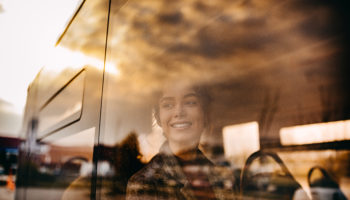On the occasion of the expansion of the Demand-Responsive Transport (DRT) service Résa’Tao in Orléans, Padam Mobility spoke to Romain Roy, Vice-President of Orléans Métropole and in charge of transport and traffic.
The main function of the on-demand service is to bring residents to the existing public transport services”.
PADAM MOBILITY (PM): How would you describe the DRT service in Orléans Métropole?
Our DRT is a modern and innovative service that Orléans developed as of 2018 and expanded in 2019 within a pilot area. It is a service linked to a software suite that has made it possible to connect 100% of the metropolitan population to structured public transport. Users can book the service a month in advance or 5 minutes before departure via a mobile app, website or toll-free phone number. A ticket is no more expensive than a traditional bus ticket, although the user can travel directly from point to point in the defined area of Orléans Métropole.
PM: How does the DRT service complement the transport offer nowadays?
RR: The DRT not only complements it but gives every resident access to a public transport service. I don’t know of any network in France or the world that has managed to cover 100% of an area with traditional transport services. There are still isolated people who live far from a bus stop. The on-demand service can, therefore, also pick up people living far away from the Orléans city centre. However, this is not the only benefit of the DRT! It also allows people to move from point to point within the suburbs as more and more new lines are being created.
PM: What kind of users or purposes are served by Demand-Responsive Transport?
RR: Truly all of them! We don’t exclude anyone. We pick up schoolchildren in the morning, pensioners in the afternoon, people with reduced mobility, professionals, people who use the service sporadically, people without a car, etc. We connect all users with a service that is demand-oriented and close to the customer.
PM: What are the concrete advantages of this DRT service?
RR: The obvious benefit is that users are connected and that the service does not exclude any user. Mobility means demand-responsive transport, it means walking, cycling, park-and-ride, tram, bus, but first and foremost you need access to these transport options. And the primary service that DRT provides is to get residents to the structuring public transport network. Next, there is the temporal scope of the service: from 6 am to 9 pm, 7 days a week. Last but not least, it is a customer-oriented service. You no longer have to wait 30 minutes for your bus; if you book in advance, you can literally get your bus right in front of your door. For the time being, however, the service is only available from point to point, not yet from address to address. It is a local transport service at an ultra-competitive cost, shared but no more expensive than traditional public transport.
We feel that we are better investing taxpayers’ money, especially since the strategy of Orléans Métropole is not to gain economic advantages but to provide a better service”.
PM: How has technology helped you realise this vision?
RR: We started a trial area in 2018-2019 with 4-5 vehicles on a smaller operational area and a more limited time frame. This test showed us that users were satisfied and that demand was increasing. In 2019, based on the good test results, we decided, together with Keolis and Padam Mobility, to continue the experiment and expanded the test area to 9 test areas with 12-14 vehicles each with different time frames and different focus groups. Based on these two test trials and our conviction that Transport-on-Demand will be the mobility of tomorrow, we decided to expand the service to 4 large, newly designed zones from 3 January [2022], served by a total of 40 vehicles 7 days a week.
PM: Can you say something about economic rationality and what the technology can do for the community in terms of cost?
RR: Based on the 2019-2020 figures provided to us by our contractor [Keolis Métropole Orléans], the economic balance that the metropolis is aiming for is close to zero. Of the 11.6 million km purchased from our contractor, we have transferred almost 600,000 km to on-demand transport. 1 km with a traditional large bus, which also often runs without passengers, costs between 3 and 4 euros. 1 km with a smaller shuttle bus, which is rarely empty as it comes on demand and can be shared, is cheaper. The equation is balanced because we enable a customer-oriented and flexible service for the user. We feel that we are better investing taxpayers’ money, especially since the strategy of Orléans Métropole is not to gain economic advantages but to provide a better service.
PM: How did Padam Mobility accompany you to enable such an efficient service?
RR: Co-creation, exchange, many discussions, dialogues and tackling challenges, because there is a common interest between the metropolis, the contractor [Keolis Métropole Orléans] and Padam Mobility, which we achieve through professionalism, growth and innovation. We are proud to have been among the first to put our trust in you. We are also happy to see that our achievements and the result have been transferred to different areas. We are convinced that it was right to trust you and to reinforce the offer. Other factors were also taken into account: the mobility needs of the territory, the satisfaction and response of users, proximity, the safety aspect, etc.
PM: What are the environmental impacts of DRT?
RR: Environmental awareness must be strengthened. We have taken lots of big buses out of service. Based on data and statistics, we have also cancelled lines that had hardly any more passengers. We have organised bus services in the metropolis according to school and holiday times as well as according to different times of the day. A large electric bus that doesn’t find its audience and runs empty will always be less environmentally friendly than several small shuttle buses that use hybrid or electric power and are operating at good capacity. Using the service is not only an economic but certainly an ecological gesture.
For us, the on-demand service is a tool to attract new users, in addition to connecting 100% of the users in the metropolis.”
PM: What are the goals of the Transport on Demand service in Orléans?
RR: We are in a growth phase where we are trying something new, but also measuring and controlling because we have a duty to provide quality services. That means we have to have a shuttle that is on time, that transports you safely and that connects you with other mobility services. If users give up their private cars, the bet is already won, both environmentally and socially. The goal is to shift more traditional bus kilometres to on-demand transport. Instead of having four big zones that are almost identical, we want to merge them and then, why not, think about on-demand night transport, which will certainly find its audience.
PM: To which strategy regarding the modal shift does Transport-on-Demand fit?
RR: The first strategy is to offer a service that we believe is truly relevant to our times. The fact that it is a responsive and intuitive local transport service allows passengers to easily understand it right from the start. If they want to get on an on-demand service and go from A to B, they can be sure that their transport is reliable. For us, the on-demand service is a tool to attract new users, in addition to connecting 100% of the users in the metropolis. It is really the extended arm of conventional public transport.
PM: Would you say that on-demand mobility brings new users to public transport?
RR: For sure, yes. Because on-demand transport appeals to everyone: the young generation, who are hyper-connected, and the other part of the population, who are less connected or live more isolated. Orléans Métropole has managed to maintain a toll-free number that allows people to stay directly connected during operating hours so they can book their transport. Thus, we also reassure people who are less tech-savvy. The fact that we provide multiple booking channels to connect people from their homes to a transport service will inevitably attract new audiences. We see this in the satisfaction rates. From pensioners who have a doctor’s appointment to young people who want a lift to school: We offer an innovative service that engages all segments of the population.
Learn more about Padam Mobility
This article might interest you as well: The Orléans metropolis expands its on-demand network Résa’Tao to four additional zones





